Systematic Review: Factors Influencing HPV Vaccine Decisions
VerifiedAdded on 2023/04/20
|55
|10165
|73
Literature Review
AI Summary
This systematic review investigates the factors influencing parental decisions regarding Human Papilloma Virus (HPV) vaccination. The review analyzes peer-reviewed articles, identifying key themes such as susceptibility and age of children, educational attainment, apprehension regarding vaccine effectiveness and safety, and religious affiliation, ethnicity, and socioeconomic status. The findings suggest that parental attitudes are crucial for HPV vaccination outcomes, with poor understanding of vaccine benefits leading to reluctance. Recommendations from healthcare professionals, awareness campaigns, and addressing concerns about vaccine safety are vital for increasing vaccination rates. The review highlights the importance of parent-child communication about sexual health and the role of nurses in promoting HPV vaccination.
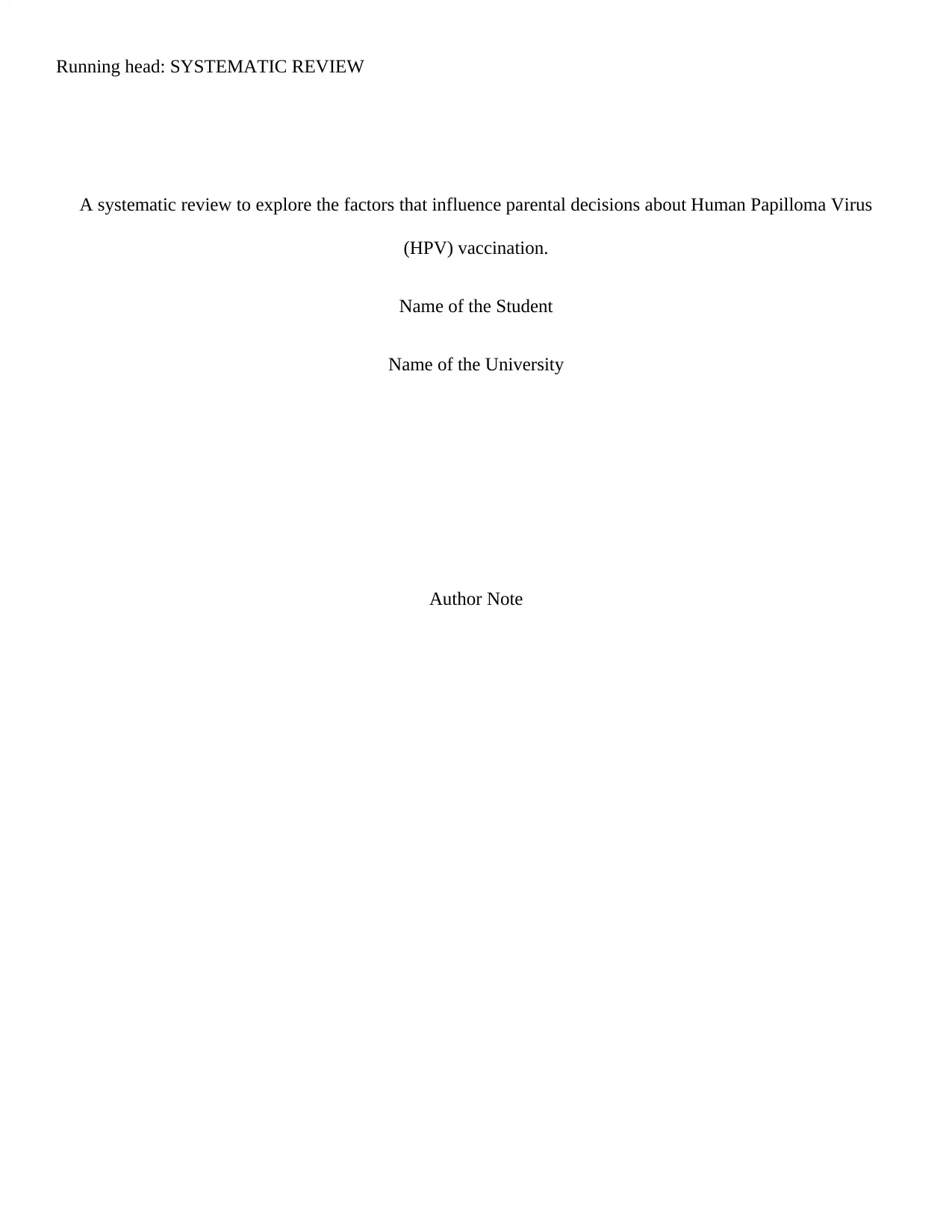
Running head: SYSTEMATIC REVIEW
A systematic review to explore the factors that influence parental decisions about Human Papilloma Virus
(HPV) vaccination.
Name of the Student
Name of the University
Author Note
A systematic review to explore the factors that influence parental decisions about Human Papilloma Virus
(HPV) vaccination.
Name of the Student
Name of the University
Author Note
Paraphrase This Document
Need a fresh take? Get an instant paraphrase of this document with our AI Paraphraser
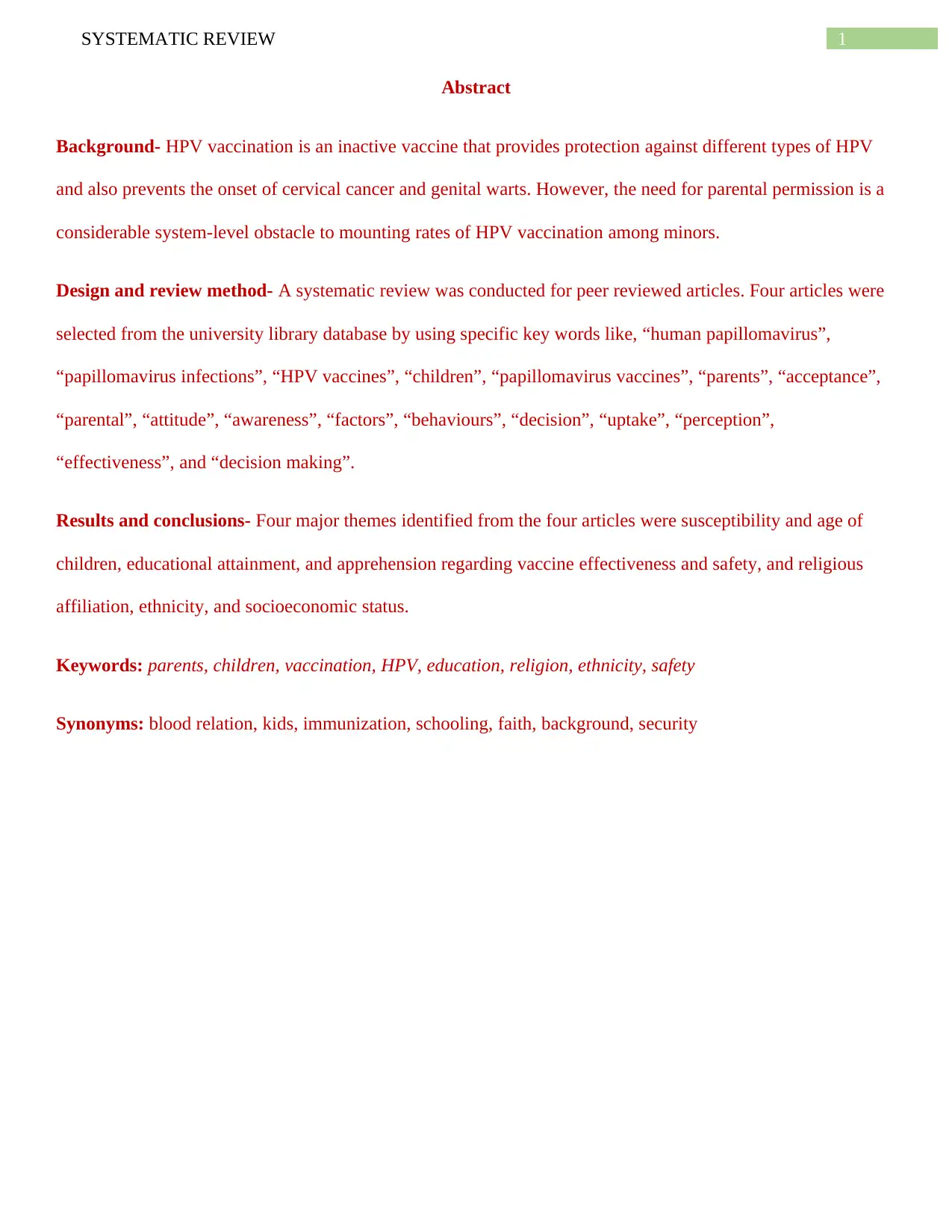
1SYSTEMATIC REVIEW
Abstract
Background- HPV vaccination is an inactive vaccine that provides protection against different types of HPV
and also prevents the onset of cervical cancer and genital warts. However, the need for parental permission is a
considerable system-level obstacle to mounting rates of HPV vaccination among minors.
Design and review method- A systematic review was conducted for peer reviewed articles. Four articles were
selected from the university library database by using specific key words like, “human papillomavirus”,
“papillomavirus infections”, “HPV vaccines”, “children”, “papillomavirus vaccines”, “parents”, “acceptance”,
“parental”, “attitude”, “awareness”, “factors”, “behaviours”, “decision”, “uptake”, “perception”,
“effectiveness”, and “decision making”.
Results and conclusions- Four major themes identified from the four articles were susceptibility and age of
children, educational attainment, and apprehension regarding vaccine effectiveness and safety, and religious
affiliation, ethnicity, and socioeconomic status.
Keywords: parents, children, vaccination, HPV, education, religion, ethnicity, safety
Synonyms: blood relation, kids, immunization, schooling, faith, background, security
Abstract
Background- HPV vaccination is an inactive vaccine that provides protection against different types of HPV
and also prevents the onset of cervical cancer and genital warts. However, the need for parental permission is a
considerable system-level obstacle to mounting rates of HPV vaccination among minors.
Design and review method- A systematic review was conducted for peer reviewed articles. Four articles were
selected from the university library database by using specific key words like, “human papillomavirus”,
“papillomavirus infections”, “HPV vaccines”, “children”, “papillomavirus vaccines”, “parents”, “acceptance”,
“parental”, “attitude”, “awareness”, “factors”, “behaviours”, “decision”, “uptake”, “perception”,
“effectiveness”, and “decision making”.
Results and conclusions- Four major themes identified from the four articles were susceptibility and age of
children, educational attainment, and apprehension regarding vaccine effectiveness and safety, and religious
affiliation, ethnicity, and socioeconomic status.
Keywords: parents, children, vaccination, HPV, education, religion, ethnicity, safety
Synonyms: blood relation, kids, immunization, schooling, faith, background, security
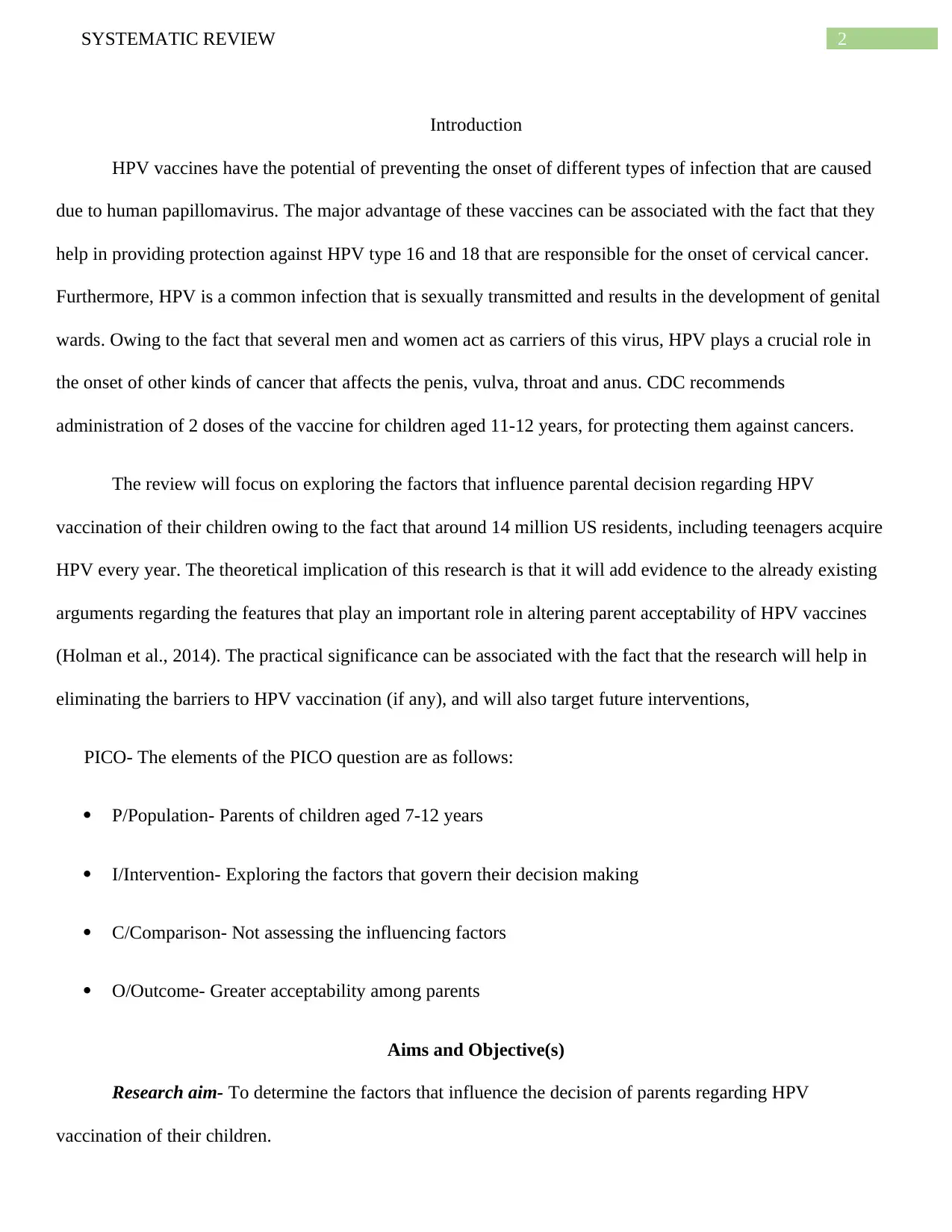
2SYSTEMATIC REVIEW
Introduction
HPV vaccines have the potential of preventing the onset of different types of infection that are caused
due to human papillomavirus. The major advantage of these vaccines can be associated with the fact that they
help in providing protection against HPV type 16 and 18 that are responsible for the onset of cervical cancer.
Furthermore, HPV is a common infection that is sexually transmitted and results in the development of genital
wards. Owing to the fact that several men and women act as carriers of this virus, HPV plays a crucial role in
the onset of other kinds of cancer that affects the penis, vulva, throat and anus. CDC recommends
administration of 2 doses of the vaccine for children aged 11-12 years, for protecting them against cancers.
The review will focus on exploring the factors that influence parental decision regarding HPV
vaccination of their children owing to the fact that around 14 million US residents, including teenagers acquire
HPV every year. The theoretical implication of this research is that it will add evidence to the already existing
arguments regarding the features that play an important role in altering parent acceptability of HPV vaccines
(Holman et al., 2014). The practical significance can be associated with the fact that the research will help in
eliminating the barriers to HPV vaccination (if any), and will also target future interventions,
PICO- The elements of the PICO question are as follows:
P/Population- Parents of children aged 7-12 years
I/Intervention- Exploring the factors that govern their decision making
C/Comparison- Not assessing the influencing factors
O/Outcome- Greater acceptability among parents
Aims and Objective(s)
Research aim- To determine the factors that influence the decision of parents regarding HPV
vaccination of their children.
Introduction
HPV vaccines have the potential of preventing the onset of different types of infection that are caused
due to human papillomavirus. The major advantage of these vaccines can be associated with the fact that they
help in providing protection against HPV type 16 and 18 that are responsible for the onset of cervical cancer.
Furthermore, HPV is a common infection that is sexually transmitted and results in the development of genital
wards. Owing to the fact that several men and women act as carriers of this virus, HPV plays a crucial role in
the onset of other kinds of cancer that affects the penis, vulva, throat and anus. CDC recommends
administration of 2 doses of the vaccine for children aged 11-12 years, for protecting them against cancers.
The review will focus on exploring the factors that influence parental decision regarding HPV
vaccination of their children owing to the fact that around 14 million US residents, including teenagers acquire
HPV every year. The theoretical implication of this research is that it will add evidence to the already existing
arguments regarding the features that play an important role in altering parent acceptability of HPV vaccines
(Holman et al., 2014). The practical significance can be associated with the fact that the research will help in
eliminating the barriers to HPV vaccination (if any), and will also target future interventions,
PICO- The elements of the PICO question are as follows:
P/Population- Parents of children aged 7-12 years
I/Intervention- Exploring the factors that govern their decision making
C/Comparison- Not assessing the influencing factors
O/Outcome- Greater acceptability among parents
Aims and Objective(s)
Research aim- To determine the factors that influence the decision of parents regarding HPV
vaccination of their children.
⊘ This is a preview!⊘
Do you want full access?
Subscribe today to unlock all pages.

Trusted by 1+ million students worldwide
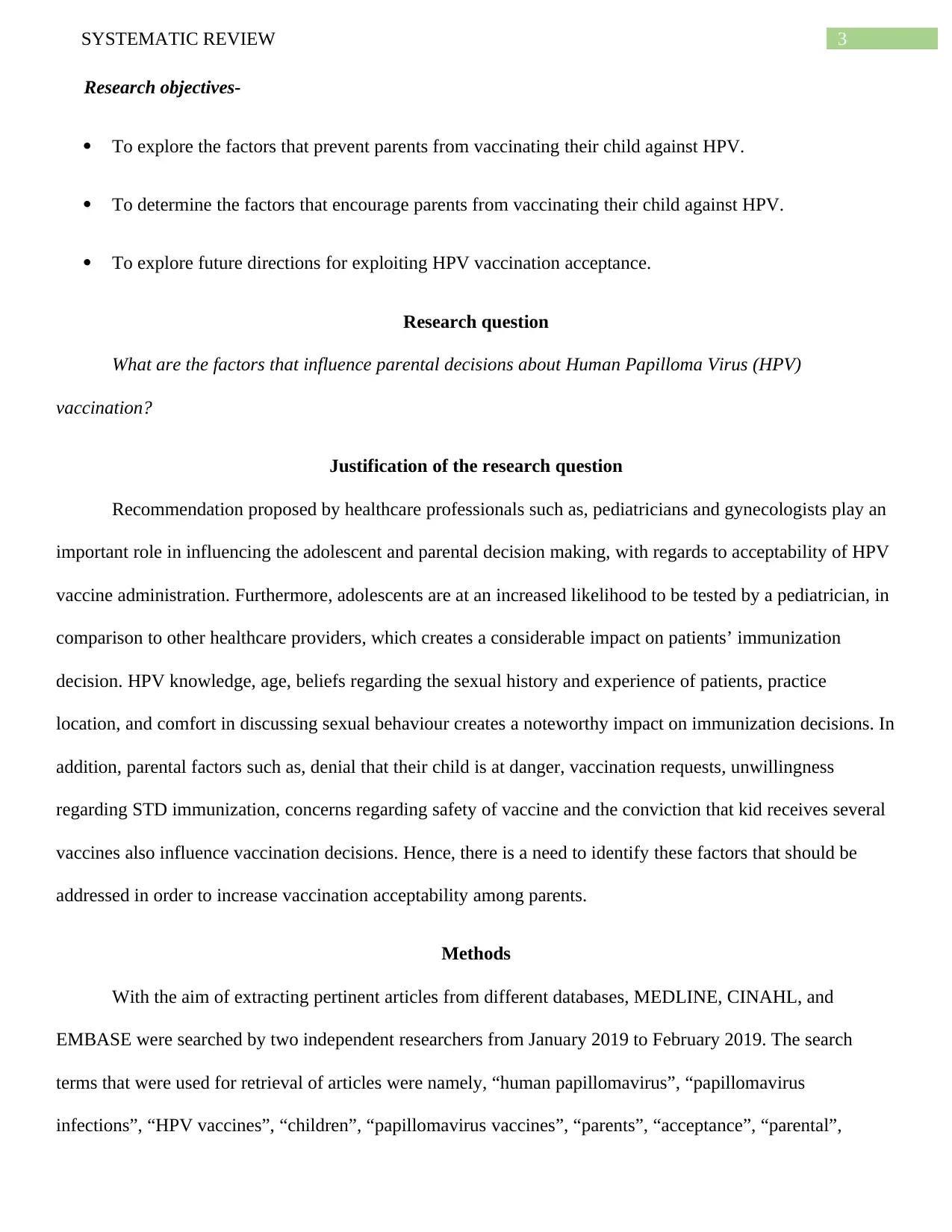
3SYSTEMATIC REVIEW
Research objectives-
To explore the factors that prevent parents from vaccinating their child against HPV.
To determine the factors that encourage parents from vaccinating their child against HPV.
To explore future directions for exploiting HPV vaccination acceptance.
Research question
What are the factors that influence parental decisions about Human Papilloma Virus (HPV)
vaccination?
Justification of the research question
Recommendation proposed by healthcare professionals such as, pediatricians and gynecologists play an
important role in influencing the adolescent and parental decision making, with regards to acceptability of HPV
vaccine administration. Furthermore, adolescents are at an increased likelihood to be tested by a pediatrician, in
comparison to other healthcare providers, which creates a considerable impact on patients’ immunization
decision. HPV knowledge, age, beliefs regarding the sexual history and experience of patients, practice
location, and comfort in discussing sexual behaviour creates a noteworthy impact on immunization decisions. In
addition, parental factors such as, denial that their child is at danger, vaccination requests, unwillingness
regarding STD immunization, concerns regarding safety of vaccine and the conviction that kid receives several
vaccines also influence vaccination decisions. Hence, there is a need to identify these factors that should be
addressed in order to increase vaccination acceptability among parents.
Methods
With the aim of extracting pertinent articles from different databases, MEDLINE, CINAHL, and
EMBASE were searched by two independent researchers from January 2019 to February 2019. The search
terms that were used for retrieval of articles were namely, “human papillomavirus”, “papillomavirus
infections”, “HPV vaccines”, “children”, “papillomavirus vaccines”, “parents”, “acceptance”, “parental”,
Research objectives-
To explore the factors that prevent parents from vaccinating their child against HPV.
To determine the factors that encourage parents from vaccinating their child against HPV.
To explore future directions for exploiting HPV vaccination acceptance.
Research question
What are the factors that influence parental decisions about Human Papilloma Virus (HPV)
vaccination?
Justification of the research question
Recommendation proposed by healthcare professionals such as, pediatricians and gynecologists play an
important role in influencing the adolescent and parental decision making, with regards to acceptability of HPV
vaccine administration. Furthermore, adolescents are at an increased likelihood to be tested by a pediatrician, in
comparison to other healthcare providers, which creates a considerable impact on patients’ immunization
decision. HPV knowledge, age, beliefs regarding the sexual history and experience of patients, practice
location, and comfort in discussing sexual behaviour creates a noteworthy impact on immunization decisions. In
addition, parental factors such as, denial that their child is at danger, vaccination requests, unwillingness
regarding STD immunization, concerns regarding safety of vaccine and the conviction that kid receives several
vaccines also influence vaccination decisions. Hence, there is a need to identify these factors that should be
addressed in order to increase vaccination acceptability among parents.
Methods
With the aim of extracting pertinent articles from different databases, MEDLINE, CINAHL, and
EMBASE were searched by two independent researchers from January 2019 to February 2019. The search
terms that were used for retrieval of articles were namely, “human papillomavirus”, “papillomavirus
infections”, “HPV vaccines”, “children”, “papillomavirus vaccines”, “parents”, “acceptance”, “parental”,
Paraphrase This Document
Need a fresh take? Get an instant paraphrase of this document with our AI Paraphraser
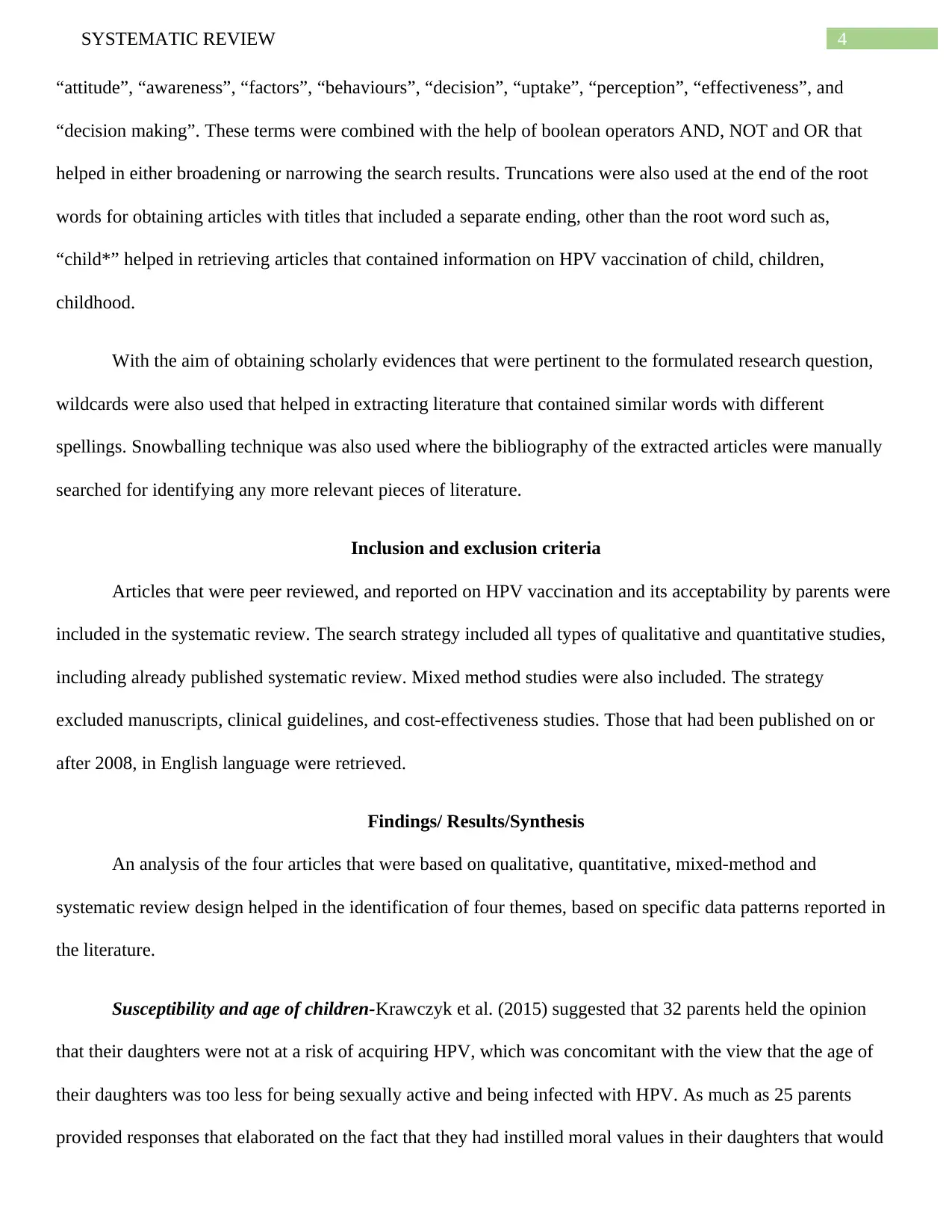
4SYSTEMATIC REVIEW
“attitude”, “awareness”, “factors”, “behaviours”, “decision”, “uptake”, “perception”, “effectiveness”, and
“decision making”. These terms were combined with the help of boolean operators AND, NOT and OR that
helped in either broadening or narrowing the search results. Truncations were also used at the end of the root
words for obtaining articles with titles that included a separate ending, other than the root word such as,
“child*” helped in retrieving articles that contained information on HPV vaccination of child, children,
childhood.
With the aim of obtaining scholarly evidences that were pertinent to the formulated research question,
wildcards were also used that helped in extracting literature that contained similar words with different
spellings. Snowballing technique was also used where the bibliography of the extracted articles were manually
searched for identifying any more relevant pieces of literature.
Inclusion and exclusion criteria
Articles that were peer reviewed, and reported on HPV vaccination and its acceptability by parents were
included in the systematic review. The search strategy included all types of qualitative and quantitative studies,
including already published systematic review. Mixed method studies were also included. The strategy
excluded manuscripts, clinical guidelines, and cost-effectiveness studies. Those that had been published on or
after 2008, in English language were retrieved.
Findings/ Results/Synthesis
An analysis of the four articles that were based on qualitative, quantitative, mixed-method and
systematic review design helped in the identification of four themes, based on specific data patterns reported in
the literature.
Susceptibility and age of children-Krawczyk et al. (2015) suggested that 32 parents held the opinion
that their daughters were not at a risk of acquiring HPV, which was concomitant with the view that the age of
their daughters was too less for being sexually active and being infected with HPV. As much as 25 parents
provided responses that elaborated on the fact that they had instilled moral values in their daughters that would
“attitude”, “awareness”, “factors”, “behaviours”, “decision”, “uptake”, “perception”, “effectiveness”, and
“decision making”. These terms were combined with the help of boolean operators AND, NOT and OR that
helped in either broadening or narrowing the search results. Truncations were also used at the end of the root
words for obtaining articles with titles that included a separate ending, other than the root word such as,
“child*” helped in retrieving articles that contained information on HPV vaccination of child, children,
childhood.
With the aim of obtaining scholarly evidences that were pertinent to the formulated research question,
wildcards were also used that helped in extracting literature that contained similar words with different
spellings. Snowballing technique was also used where the bibliography of the extracted articles were manually
searched for identifying any more relevant pieces of literature.
Inclusion and exclusion criteria
Articles that were peer reviewed, and reported on HPV vaccination and its acceptability by parents were
included in the systematic review. The search strategy included all types of qualitative and quantitative studies,
including already published systematic review. Mixed method studies were also included. The strategy
excluded manuscripts, clinical guidelines, and cost-effectiveness studies. Those that had been published on or
after 2008, in English language were retrieved.
Findings/ Results/Synthesis
An analysis of the four articles that were based on qualitative, quantitative, mixed-method and
systematic review design helped in the identification of four themes, based on specific data patterns reported in
the literature.
Susceptibility and age of children-Krawczyk et al. (2015) suggested that 32 parents held the opinion
that their daughters were not at a risk of acquiring HPV, which was concomitant with the view that the age of
their daughters was too less for being sexually active and being infected with HPV. As much as 25 parents
provided responses that elaborated on the fact that they had instilled moral values in their daughters that would
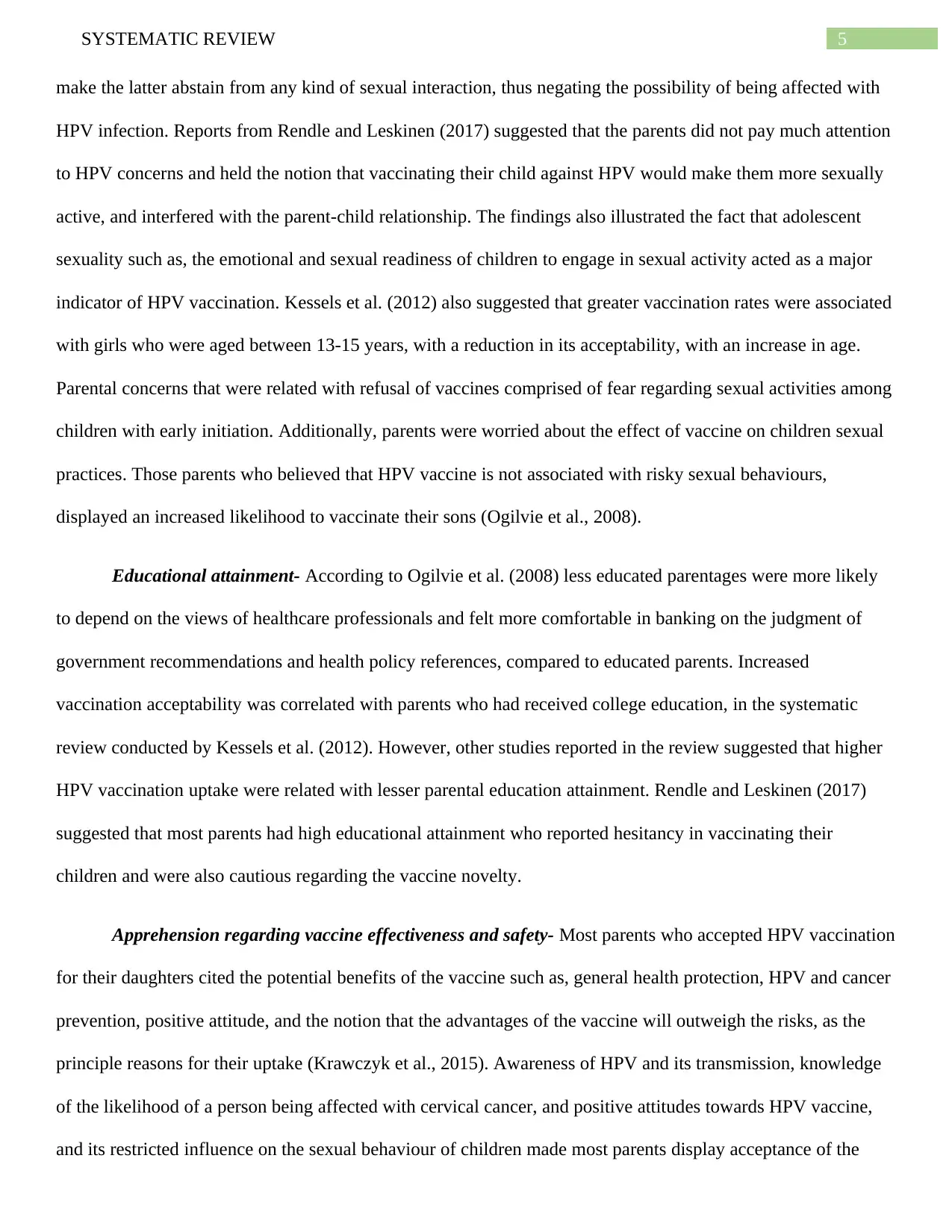
5SYSTEMATIC REVIEW
make the latter abstain from any kind of sexual interaction, thus negating the possibility of being affected with
HPV infection. Reports from Rendle and Leskinen (2017) suggested that the parents did not pay much attention
to HPV concerns and held the notion that vaccinating their child against HPV would make them more sexually
active, and interfered with the parent-child relationship. The findings also illustrated the fact that adolescent
sexuality such as, the emotional and sexual readiness of children to engage in sexual activity acted as a major
indicator of HPV vaccination. Kessels et al. (2012) also suggested that greater vaccination rates were associated
with girls who were aged between 13-15 years, with a reduction in its acceptability, with an increase in age.
Parental concerns that were related with refusal of vaccines comprised of fear regarding sexual activities among
children with early initiation. Additionally, parents were worried about the effect of vaccine on children sexual
practices. Those parents who believed that HPV vaccine is not associated with risky sexual behaviours,
displayed an increased likelihood to vaccinate their sons (Ogilvie et al., 2008).
Educational attainment- According to Ogilvie et al. (2008) less educated parentages were more likely
to depend on the views of healthcare professionals and felt more comfortable in banking on the judgment of
government recommendations and health policy references, compared to educated parents. Increased
vaccination acceptability was correlated with parents who had received college education, in the systematic
review conducted by Kessels et al. (2012). However, other studies reported in the review suggested that higher
HPV vaccination uptake were related with lesser parental education attainment. Rendle and Leskinen (2017)
suggested that most parents had high educational attainment who reported hesitancy in vaccinating their
children and were also cautious regarding the vaccine novelty.
Apprehension regarding vaccine effectiveness and safety- Most parents who accepted HPV vaccination
for their daughters cited the potential benefits of the vaccine such as, general health protection, HPV and cancer
prevention, positive attitude, and the notion that the advantages of the vaccine will outweigh the risks, as the
principle reasons for their uptake (Krawczyk et al., 2015). Awareness of HPV and its transmission, knowledge
of the likelihood of a person being affected with cervical cancer, and positive attitudes towards HPV vaccine,
and its restricted influence on the sexual behaviour of children made most parents display acceptance of the
make the latter abstain from any kind of sexual interaction, thus negating the possibility of being affected with
HPV infection. Reports from Rendle and Leskinen (2017) suggested that the parents did not pay much attention
to HPV concerns and held the notion that vaccinating their child against HPV would make them more sexually
active, and interfered with the parent-child relationship. The findings also illustrated the fact that adolescent
sexuality such as, the emotional and sexual readiness of children to engage in sexual activity acted as a major
indicator of HPV vaccination. Kessels et al. (2012) also suggested that greater vaccination rates were associated
with girls who were aged between 13-15 years, with a reduction in its acceptability, with an increase in age.
Parental concerns that were related with refusal of vaccines comprised of fear regarding sexual activities among
children with early initiation. Additionally, parents were worried about the effect of vaccine on children sexual
practices. Those parents who believed that HPV vaccine is not associated with risky sexual behaviours,
displayed an increased likelihood to vaccinate their sons (Ogilvie et al., 2008).
Educational attainment- According to Ogilvie et al. (2008) less educated parentages were more likely
to depend on the views of healthcare professionals and felt more comfortable in banking on the judgment of
government recommendations and health policy references, compared to educated parents. Increased
vaccination acceptability was correlated with parents who had received college education, in the systematic
review conducted by Kessels et al. (2012). However, other studies reported in the review suggested that higher
HPV vaccination uptake were related with lesser parental education attainment. Rendle and Leskinen (2017)
suggested that most parents had high educational attainment who reported hesitancy in vaccinating their
children and were also cautious regarding the vaccine novelty.
Apprehension regarding vaccine effectiveness and safety- Most parents who accepted HPV vaccination
for their daughters cited the potential benefits of the vaccine such as, general health protection, HPV and cancer
prevention, positive attitude, and the notion that the advantages of the vaccine will outweigh the risks, as the
principle reasons for their uptake (Krawczyk et al., 2015). Awareness of HPV and its transmission, knowledge
of the likelihood of a person being affected with cervical cancer, and positive attitudes towards HPV vaccine,
and its restricted influence on the sexual behaviour of children made most parents display acceptance of the
⊘ This is a preview!⊘
Do you want full access?
Subscribe today to unlock all pages.

Trusted by 1+ million students worldwide
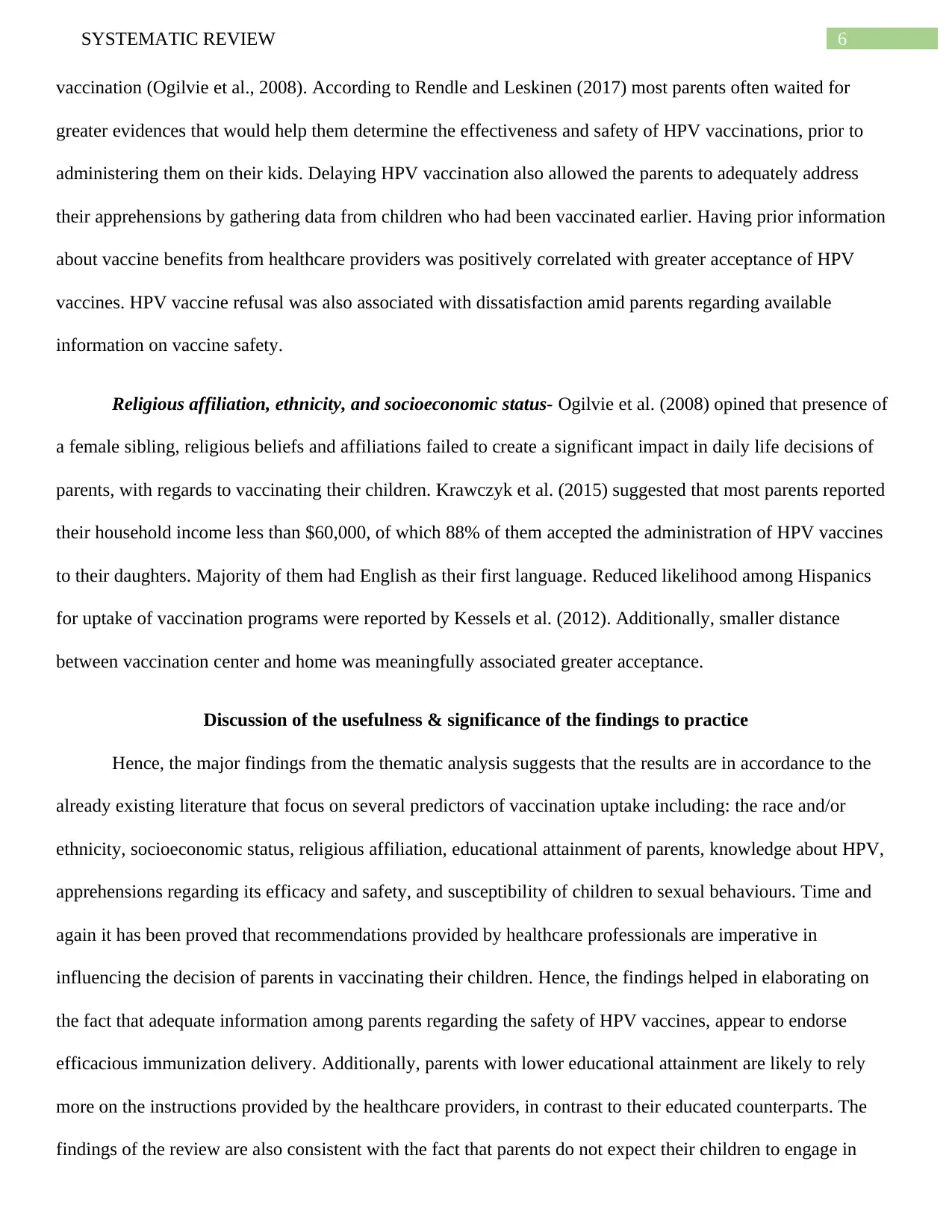
6SYSTEMATIC REVIEW
vaccination (Ogilvie et al., 2008). According to Rendle and Leskinen (2017) most parents often waited for
greater evidences that would help them determine the effectiveness and safety of HPV vaccinations, prior to
administering them on their kids. Delaying HPV vaccination also allowed the parents to adequately address
their apprehensions by gathering data from children who had been vaccinated earlier. Having prior information
about vaccine benefits from healthcare providers was positively correlated with greater acceptance of HPV
vaccines. HPV vaccine refusal was also associated with dissatisfaction amid parents regarding available
information on vaccine safety.
Religious affiliation, ethnicity, and socioeconomic status- Ogilvie et al. (2008) opined that presence of
a female sibling, religious beliefs and affiliations failed to create a significant impact in daily life decisions of
parents, with regards to vaccinating their children. Krawczyk et al. (2015) suggested that most parents reported
their household income less than $60,000, of which 88% of them accepted the administration of HPV vaccines
to their daughters. Majority of them had English as their first language. Reduced likelihood among Hispanics
for uptake of vaccination programs were reported by Kessels et al. (2012). Additionally, smaller distance
between vaccination center and home was meaningfully associated greater acceptance.
Discussion of the usefulness & significance of the findings to practice
Hence, the major findings from the thematic analysis suggests that the results are in accordance to the
already existing literature that focus on several predictors of vaccination uptake including: the race and/or
ethnicity, socioeconomic status, religious affiliation, educational attainment of parents, knowledge about HPV,
apprehensions regarding its efficacy and safety, and susceptibility of children to sexual behaviours. Time and
again it has been proved that recommendations provided by healthcare professionals are imperative in
influencing the decision of parents in vaccinating their children. Hence, the findings helped in elaborating on
the fact that adequate information among parents regarding the safety of HPV vaccines, appear to endorse
efficacious immunization delivery. Additionally, parents with lower educational attainment are likely to rely
more on the instructions provided by the healthcare providers, in contrast to their educated counterparts. The
findings of the review are also consistent with the fact that parents do not expect their children to engage in
vaccination (Ogilvie et al., 2008). According to Rendle and Leskinen (2017) most parents often waited for
greater evidences that would help them determine the effectiveness and safety of HPV vaccinations, prior to
administering them on their kids. Delaying HPV vaccination also allowed the parents to adequately address
their apprehensions by gathering data from children who had been vaccinated earlier. Having prior information
about vaccine benefits from healthcare providers was positively correlated with greater acceptance of HPV
vaccines. HPV vaccine refusal was also associated with dissatisfaction amid parents regarding available
information on vaccine safety.
Religious affiliation, ethnicity, and socioeconomic status- Ogilvie et al. (2008) opined that presence of
a female sibling, religious beliefs and affiliations failed to create a significant impact in daily life decisions of
parents, with regards to vaccinating their children. Krawczyk et al. (2015) suggested that most parents reported
their household income less than $60,000, of which 88% of them accepted the administration of HPV vaccines
to their daughters. Majority of them had English as their first language. Reduced likelihood among Hispanics
for uptake of vaccination programs were reported by Kessels et al. (2012). Additionally, smaller distance
between vaccination center and home was meaningfully associated greater acceptance.
Discussion of the usefulness & significance of the findings to practice
Hence, the major findings from the thematic analysis suggests that the results are in accordance to the
already existing literature that focus on several predictors of vaccination uptake including: the race and/or
ethnicity, socioeconomic status, religious affiliation, educational attainment of parents, knowledge about HPV,
apprehensions regarding its efficacy and safety, and susceptibility of children to sexual behaviours. Time and
again it has been proved that recommendations provided by healthcare professionals are imperative in
influencing the decision of parents in vaccinating their children. Hence, the findings helped in elaborating on
the fact that adequate information among parents regarding the safety of HPV vaccines, appear to endorse
efficacious immunization delivery. Additionally, parents with lower educational attainment are likely to rely
more on the instructions provided by the healthcare providers, in contrast to their educated counterparts. The
findings of the review are also consistent with the fact that parents do not expect their children to engage in
Paraphrase This Document
Need a fresh take? Get an instant paraphrase of this document with our AI Paraphraser
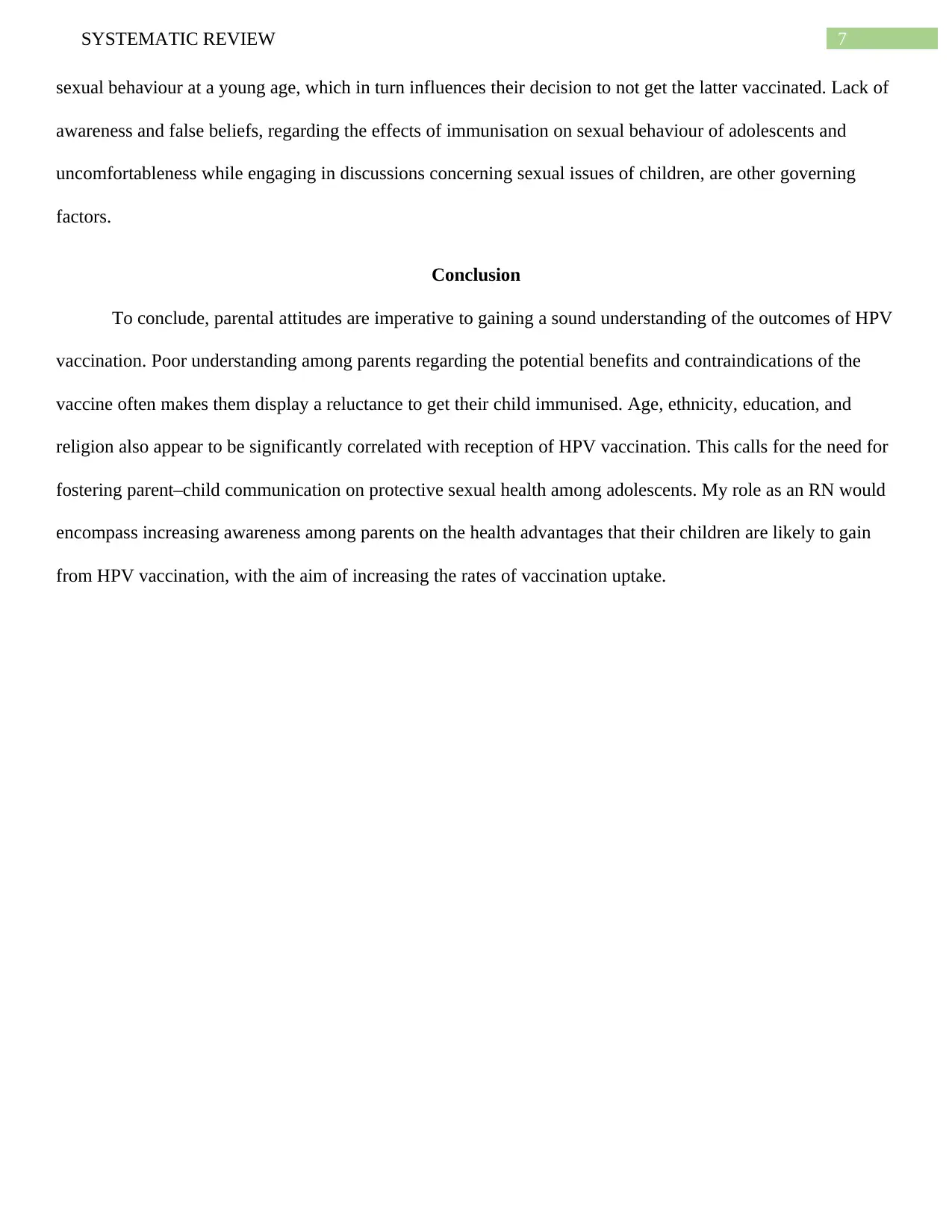
7SYSTEMATIC REVIEW
sexual behaviour at a young age, which in turn influences their decision to not get the latter vaccinated. Lack of
awareness and false beliefs, regarding the effects of immunisation on sexual behaviour of adolescents and
uncomfortableness while engaging in discussions concerning sexual issues of children, are other governing
factors.
Conclusion
To conclude, parental attitudes are imperative to gaining a sound understanding of the outcomes of HPV
vaccination. Poor understanding among parents regarding the potential benefits and contraindications of the
vaccine often makes them display a reluctance to get their child immunised. Age, ethnicity, education, and
religion also appear to be significantly correlated with reception of HPV vaccination. This calls for the need for
fostering parent–child communication on protective sexual health among adolescents. My role as an RN would
encompass increasing awareness among parents on the health advantages that their children are likely to gain
from HPV vaccination, with the aim of increasing the rates of vaccination uptake.
sexual behaviour at a young age, which in turn influences their decision to not get the latter vaccinated. Lack of
awareness and false beliefs, regarding the effects of immunisation on sexual behaviour of adolescents and
uncomfortableness while engaging in discussions concerning sexual issues of children, are other governing
factors.
Conclusion
To conclude, parental attitudes are imperative to gaining a sound understanding of the outcomes of HPV
vaccination. Poor understanding among parents regarding the potential benefits and contraindications of the
vaccine often makes them display a reluctance to get their child immunised. Age, ethnicity, education, and
religion also appear to be significantly correlated with reception of HPV vaccination. This calls for the need for
fostering parent–child communication on protective sexual health among adolescents. My role as an RN would
encompass increasing awareness among parents on the health advantages that their children are likely to gain
from HPV vaccination, with the aim of increasing the rates of vaccination uptake.
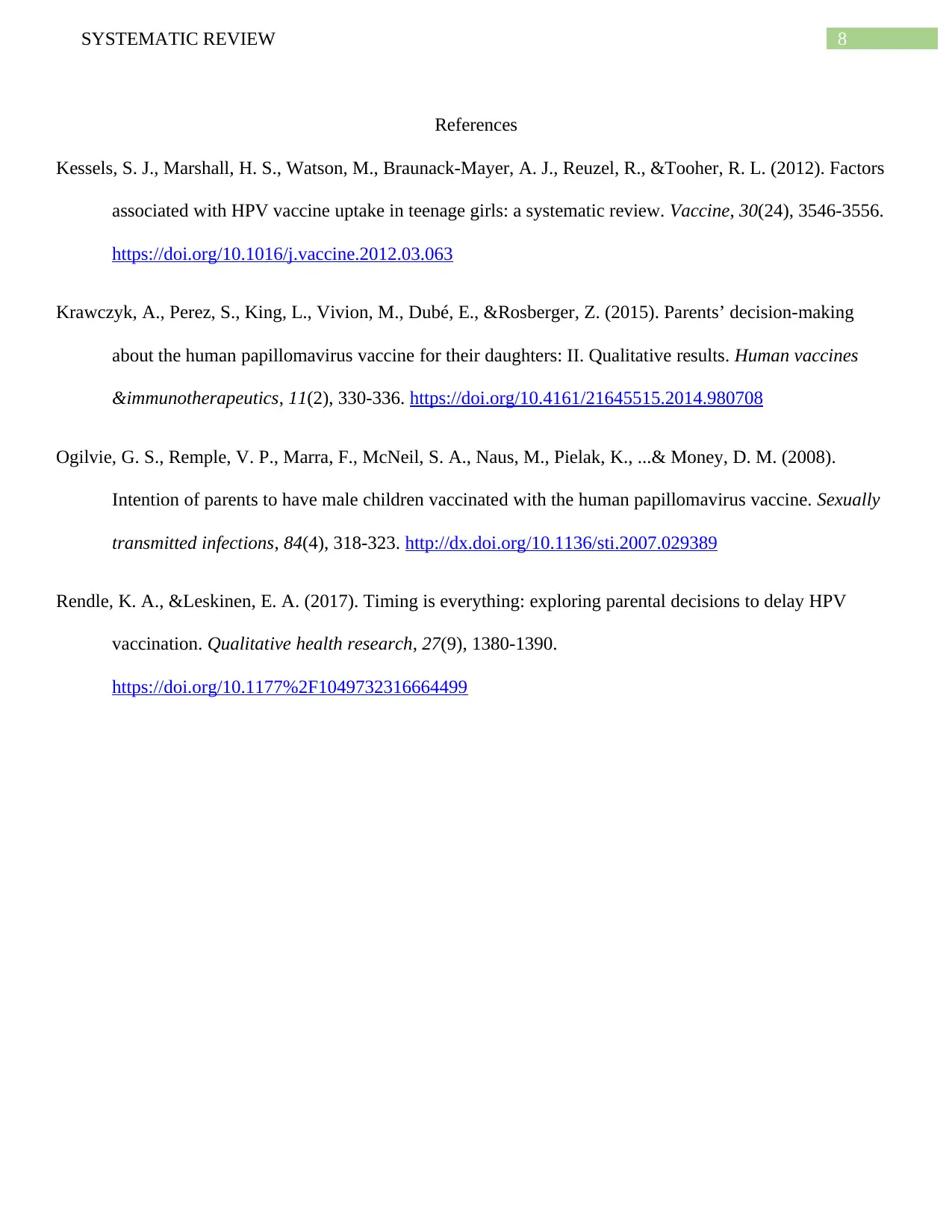
8SYSTEMATIC REVIEW
References
Kessels, S. J., Marshall, H. S., Watson, M., Braunack-Mayer, A. J., Reuzel, R., &Tooher, R. L. (2012). Factors
associated with HPV vaccine uptake in teenage girls: a systematic review. Vaccine, 30(24), 3546-3556.
https://doi.org/10.1016/j.vaccine.2012.03.063
Krawczyk, A., Perez, S., King, L., Vivion, M., Dubé, E., &Rosberger, Z. (2015). Parents’ decision-making
about the human papillomavirus vaccine for their daughters: II. Qualitative results. Human vaccines
&immunotherapeutics, 11(2), 330-336. https://doi.org/10.4161/21645515.2014.980708
Ogilvie, G. S., Remple, V. P., Marra, F., McNeil, S. A., Naus, M., Pielak, K., ...& Money, D. M. (2008).
Intention of parents to have male children vaccinated with the human papillomavirus vaccine. Sexually
transmitted infections, 84(4), 318-323. http://dx.doi.org/10.1136/sti.2007.029389
Rendle, K. A., &Leskinen, E. A. (2017). Timing is everything: exploring parental decisions to delay HPV
vaccination. Qualitative health research, 27(9), 1380-1390.
https://doi.org/10.1177%2F1049732316664499
References
Kessels, S. J., Marshall, H. S., Watson, M., Braunack-Mayer, A. J., Reuzel, R., &Tooher, R. L. (2012). Factors
associated with HPV vaccine uptake in teenage girls: a systematic review. Vaccine, 30(24), 3546-3556.
https://doi.org/10.1016/j.vaccine.2012.03.063
Krawczyk, A., Perez, S., King, L., Vivion, M., Dubé, E., &Rosberger, Z. (2015). Parents’ decision-making
about the human papillomavirus vaccine for their daughters: II. Qualitative results. Human vaccines
&immunotherapeutics, 11(2), 330-336. https://doi.org/10.4161/21645515.2014.980708
Ogilvie, G. S., Remple, V. P., Marra, F., McNeil, S. A., Naus, M., Pielak, K., ...& Money, D. M. (2008).
Intention of parents to have male children vaccinated with the human papillomavirus vaccine. Sexually
transmitted infections, 84(4), 318-323. http://dx.doi.org/10.1136/sti.2007.029389
Rendle, K. A., &Leskinen, E. A. (2017). Timing is everything: exploring parental decisions to delay HPV
vaccination. Qualitative health research, 27(9), 1380-1390.
https://doi.org/10.1177%2F1049732316664499
⊘ This is a preview!⊘
Do you want full access?
Subscribe today to unlock all pages.

Trusted by 1+ million students worldwide
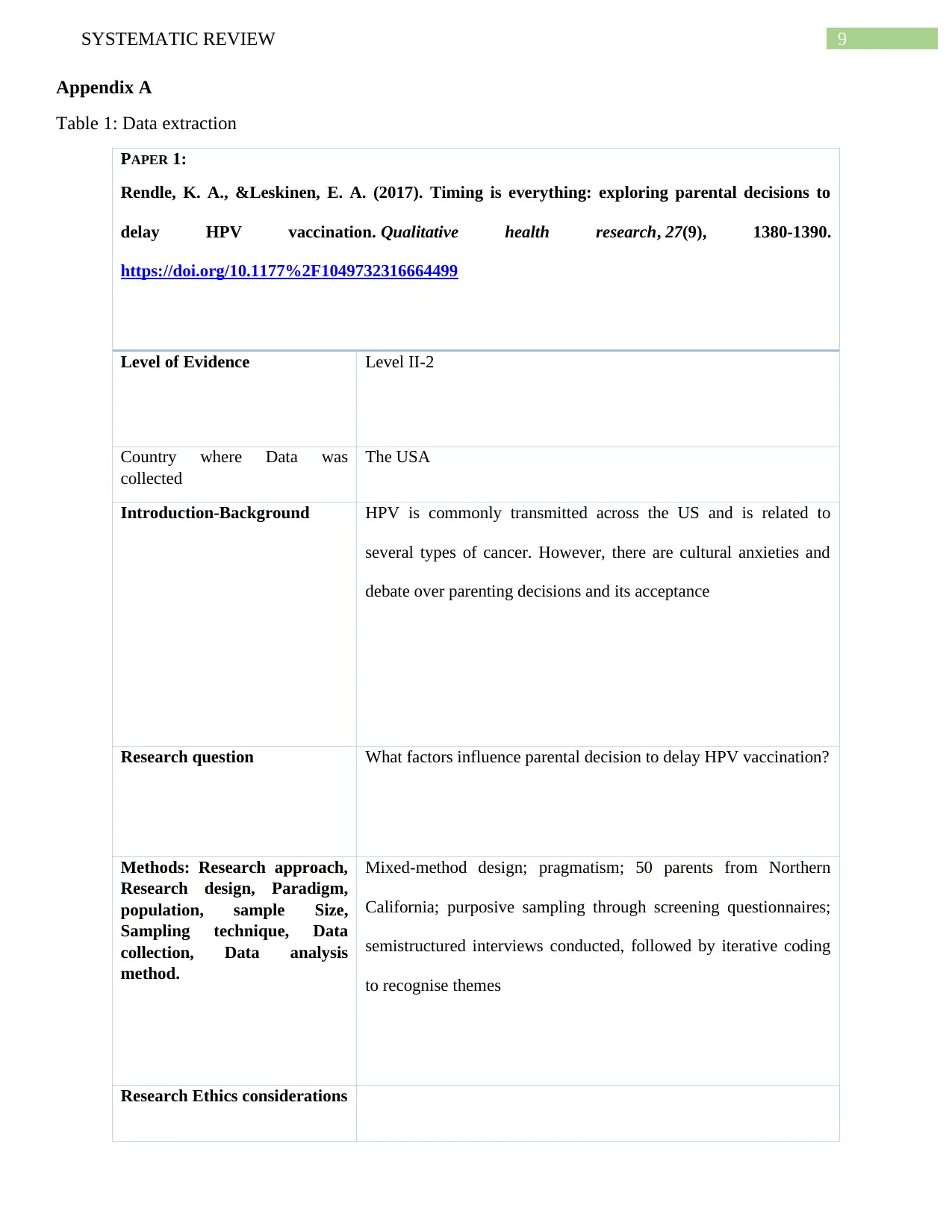
9SYSTEMATIC REVIEW
Appendix A
Table 1: Data extraction
PAPER 1:
Rendle, K. A., &Leskinen, E. A. (2017). Timing is everything: exploring parental decisions to
delay HPV vaccination. Qualitative health research, 27(9), 1380-1390.
https://doi.org/10.1177%2F1049732316664499
Level of Evidence Level II-2
Country where Data was
collected
The USA
Introduction-Background HPV is commonly transmitted across the US and is related to
several types of cancer. However, there are cultural anxieties and
debate over parenting decisions and its acceptance
Research question What factors influence parental decision to delay HPV vaccination?
Methods: Research approach,
Research design, Paradigm,
population, sample Size,
Sampling technique, Data
collection, Data analysis
method.
Mixed-method design; pragmatism; 50 parents from Northern
California; purposive sampling through screening questionnaires;
semistructured interviews conducted, followed by iterative coding
to recognise themes
Research Ethics considerations
Appendix A
Table 1: Data extraction
PAPER 1:
Rendle, K. A., &Leskinen, E. A. (2017). Timing is everything: exploring parental decisions to
delay HPV vaccination. Qualitative health research, 27(9), 1380-1390.
https://doi.org/10.1177%2F1049732316664499
Level of Evidence Level II-2
Country where Data was
collected
The USA
Introduction-Background HPV is commonly transmitted across the US and is related to
several types of cancer. However, there are cultural anxieties and
debate over parenting decisions and its acceptance
Research question What factors influence parental decision to delay HPV vaccination?
Methods: Research approach,
Research design, Paradigm,
population, sample Size,
Sampling technique, Data
collection, Data analysis
method.
Mixed-method design; pragmatism; 50 parents from Northern
California; purposive sampling through screening questionnaires;
semistructured interviews conducted, followed by iterative coding
to recognise themes
Research Ethics considerations
Paraphrase This Document
Need a fresh take? Get an instant paraphrase of this document with our AI Paraphraser
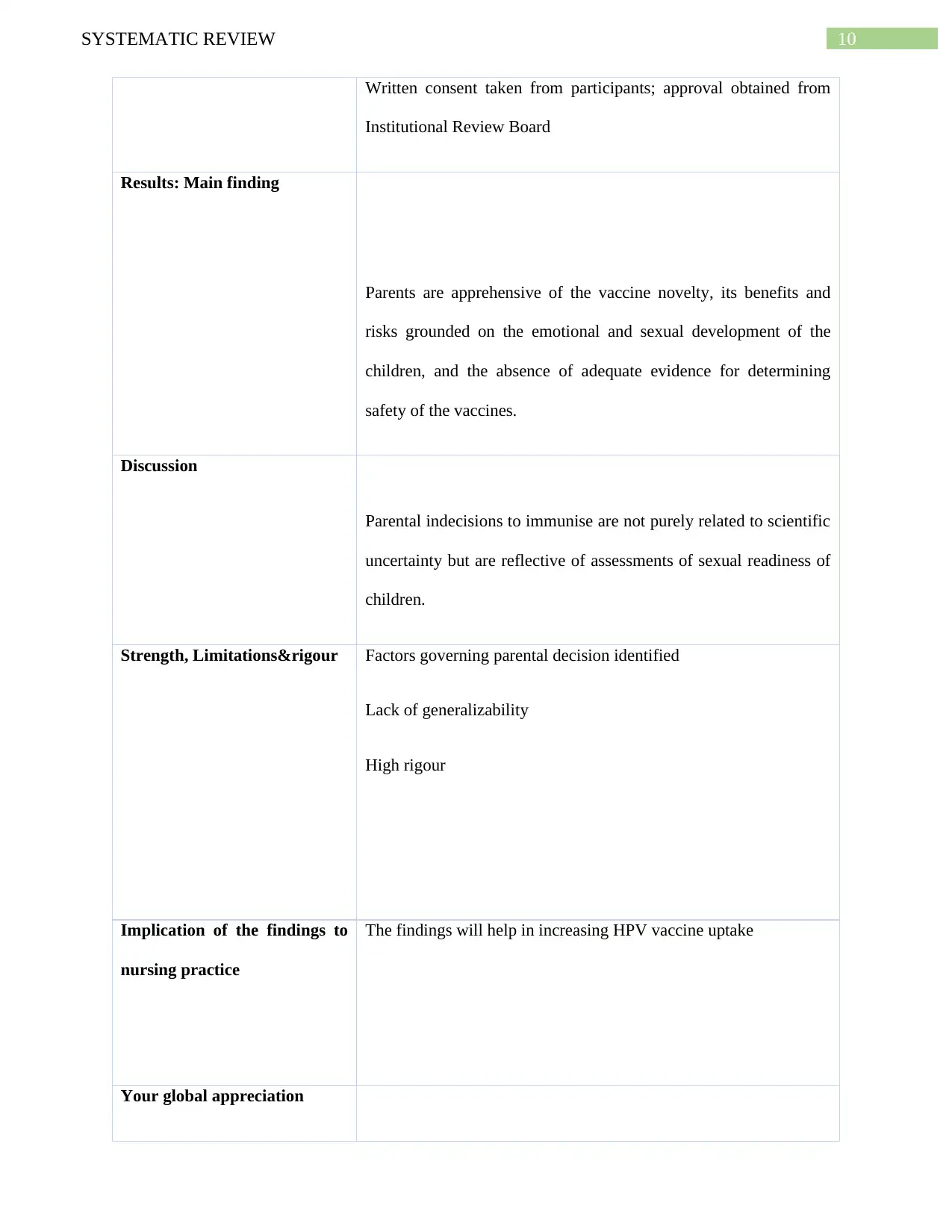
10SYSTEMATIC REVIEW
Written consent taken from participants; approval obtained from
Institutional Review Board
Results: Main finding
Parents are apprehensive of the vaccine novelty, its benefits and
risks grounded on the emotional and sexual development of the
children, and the absence of adequate evidence for determining
safety of the vaccines.
Discussion
Parental indecisions to immunise are not purely related to scientific
uncertainty but are reflective of assessments of sexual readiness of
children.
Strength, Limitations&rigour Factors governing parental decision identified
Lack of generalizability
High rigour
Implication of the findings to
nursing practice
The findings will help in increasing HPV vaccine uptake
Your global appreciation
Written consent taken from participants; approval obtained from
Institutional Review Board
Results: Main finding
Parents are apprehensive of the vaccine novelty, its benefits and
risks grounded on the emotional and sexual development of the
children, and the absence of adequate evidence for determining
safety of the vaccines.
Discussion
Parental indecisions to immunise are not purely related to scientific
uncertainty but are reflective of assessments of sexual readiness of
children.
Strength, Limitations&rigour Factors governing parental decision identified
Lack of generalizability
High rigour
Implication of the findings to
nursing practice
The findings will help in increasing HPV vaccine uptake
Your global appreciation
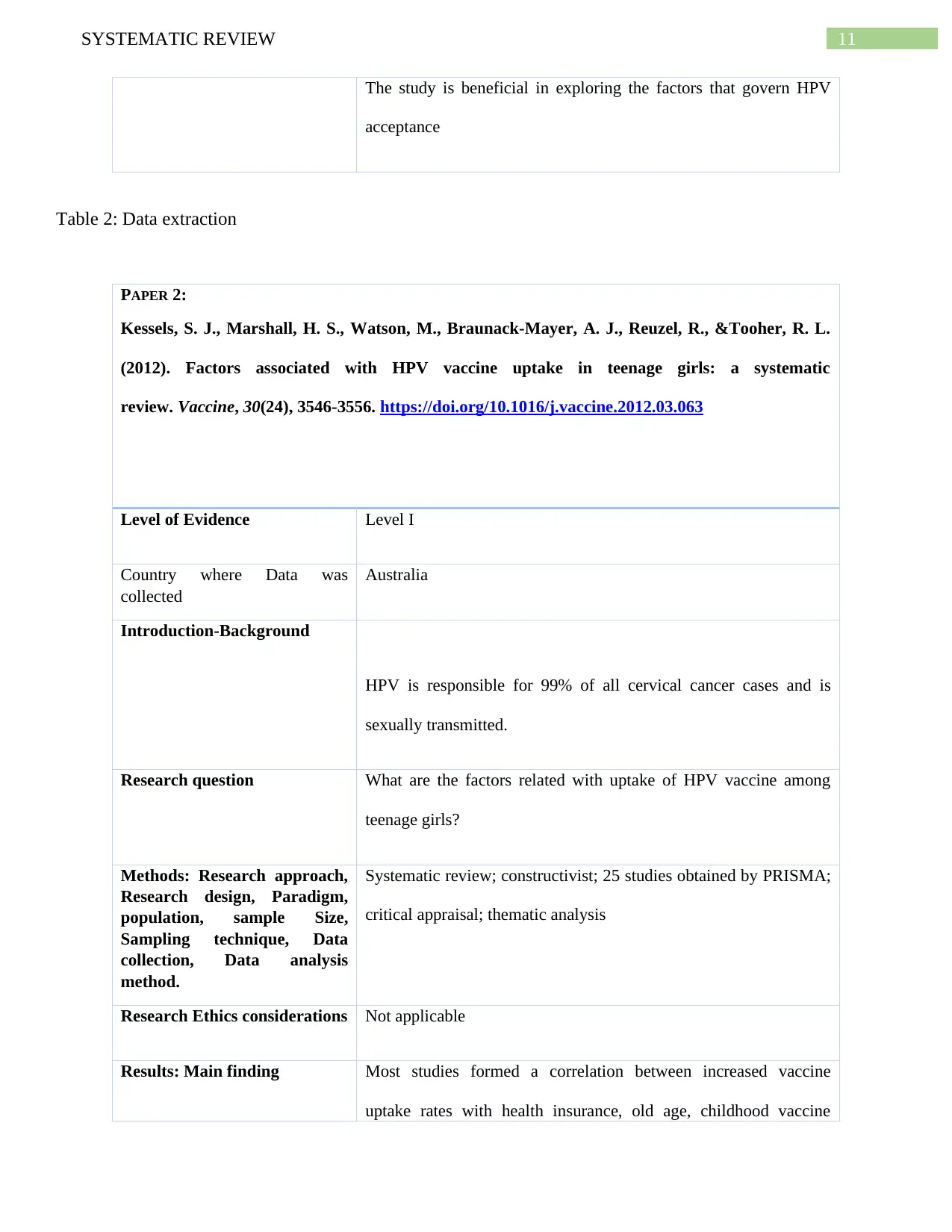
11SYSTEMATIC REVIEW
The study is beneficial in exploring the factors that govern HPV
acceptance
Table 2: Data extraction
PAPER 2:
Kessels, S. J., Marshall, H. S., Watson, M., Braunack-Mayer, A. J., Reuzel, R., &Tooher, R. L.
(2012). Factors associated with HPV vaccine uptake in teenage girls: a systematic
review. Vaccine, 30(24), 3546-3556. https://doi.org/10.1016/j.vaccine.2012.03.063
Level of Evidence Level I
Country where Data was
collected
Australia
Introduction-Background
HPV is responsible for 99% of all cervical cancer cases and is
sexually transmitted.
Research question What are the factors related with uptake of HPV vaccine among
teenage girls?
Methods: Research approach,
Research design, Paradigm,
population, sample Size,
Sampling technique, Data
collection, Data analysis
method.
Systematic review; constructivist; 25 studies obtained by PRISMA;
critical appraisal; thematic analysis
Research Ethics considerations Not applicable
Results: Main finding Most studies formed a correlation between increased vaccine
uptake rates with health insurance, old age, childhood vaccine
The study is beneficial in exploring the factors that govern HPV
acceptance
Table 2: Data extraction
PAPER 2:
Kessels, S. J., Marshall, H. S., Watson, M., Braunack-Mayer, A. J., Reuzel, R., &Tooher, R. L.
(2012). Factors associated with HPV vaccine uptake in teenage girls: a systematic
review. Vaccine, 30(24), 3546-3556. https://doi.org/10.1016/j.vaccine.2012.03.063
Level of Evidence Level I
Country where Data was
collected
Australia
Introduction-Background
HPV is responsible for 99% of all cervical cancer cases and is
sexually transmitted.
Research question What are the factors related with uptake of HPV vaccine among
teenage girls?
Methods: Research approach,
Research design, Paradigm,
population, sample Size,
Sampling technique, Data
collection, Data analysis
method.
Systematic review; constructivist; 25 studies obtained by PRISMA;
critical appraisal; thematic analysis
Research Ethics considerations Not applicable
Results: Main finding Most studies formed a correlation between increased vaccine
uptake rates with health insurance, old age, childhood vaccine
⊘ This is a preview!⊘
Do you want full access?
Subscribe today to unlock all pages.

Trusted by 1+ million students worldwide
1 out of 55
Your All-in-One AI-Powered Toolkit for Academic Success.
+13062052269
info@desklib.com
Available 24*7 on WhatsApp / Email
![[object Object]](/_next/static/media/star-bottom.7253800d.svg)
Unlock your academic potential
Copyright © 2020–2025 A2Z Services. All Rights Reserved. Developed and managed by ZUCOL.

